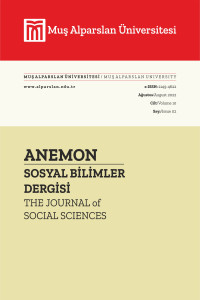Öz
Bu çalışmada amacımız, Nedîm’in “mısın kâfir” redifli gazelini klasik şerh metoduyla inceledikten sonra 20. yüzyılda ortaya çıkmış ve hayatın her alanında kendini göstermiş olan yapısalcılık yöntemiyle irdelemek ve gazelin gizli kalmış yanlarını yapısalcılık metoduyla ortaya çıkarmaktır. Yapısalcılık ekolü, metni oluşturan en küçük yapı taşlarını irdeledikten sonra, bu yapılar arasındaki anlamsal ilişkileri saptar ve bütüne uygulamayı amaç edinir. Bu yöntemle yapısalcılık ekolü metni sadece irdelemekle kalmaz aynı zamanda irdelenen metnin daha anlaşılır olmasına da olanak sağlar. Parçadan bütüne doğru ilerleyen yöntem, gazelin yapısal, anlamsal, sanatsal, gramatikal ve estetik değerinin saptanmasına yardımcı olur.
Araştırmacı tarafından incelenmeden önce yapısalcılığa uygun olarak gazelin yapısal bir iskelesi çıkartılmış, incelenecek konular belirlemiştir. Bu yapısal iskele, incelenecek metnin yapısalcılığın dışına çıkmaması için önem arz eder. İnceleme konuları gazeli ilgilendiren dış etkenlerden çok gazelin içeriğiyle alakalıdır. Gazelin incelemesinde yapı iskelesini biçim, uyak, gazelde kullanılan diller ve yabancı kelimeler, tamlama türleri ve terkipleri, cümle yapıları, harf türleri, şahıs zamirleri ve kipler, içeriği oluşturan anlam planı, imaleler ve vasıllar oluşturmuştur. Elde edilen bulgular tablolar ve grafikler aracılığıyla şarih tarafından yorumlanarak anlamlandırılmıştır.
Anahtar Kelimeler
Kaynakça
- Batislam, H. D. (2007 Eylül). Nedîm divanındaki giyim, kuşam ve süslenmeyle ilgili unsurlar. 38. ICANAS Uluslararası Asya ve Kuzey Afrika Çalışmaları Kongresi, Ankara: 1/ 261-282.
- Cevizli, A. (1999). Paradigma felsefe sözlüğü. İstanbul: Paradigma Yayınları.
- Devellioğlu, F. (2008). Osmanlıca-Türkçe ansiklopedik lûgat. Ankara: Aydın Kitabevi.
- Dilçin, C. (1991). Fuzulî'nin bir gazelinin şerhi ve yapısal yönden incelenmesi. Türkoloji, 9(1)-43-98.
- Erdem, M. (2003), Dilbilimsel eleştiri, Hece, Eleştiri Özel Sayısı, Ankara: Hece Yayınları, (6), 228-238.
- Gültekin, H. (2018 Aralık). Ali Nihad Tarlan ve edebiyat meseleleri. Hikmet-Akademik Edebiyat Dergisi (Ali Nihad Tarlan Özel Sayısı). 4/75-85.
- İpekten, H. (1994). Eski Türk edebiyatı nazım şekilleri ve aruz. İstanbul: Dergâh Yayınları.
- Kırkkılıç, H. A. (1996). Başlangıçtan günümüze tasavvuf. İstanbul: Timaş Yayınları.
- Kontantamer, T. (1993). Eski Türk edebiyatı makaleleri. Ankara: Akçağ Yayınları.
- Kur’an Yolu (Meal), Diyanet İşleri Başkanlığı (Erişim: 12.05.2021), https://kuran.diyanet.gov.tr/tefsir/Hicr-suresi/1831/29-35-ayet-tefsiri Macit, M. (1996). Divan Şiirinde Âhenk Unsurları. Ankara: Akçağ Yayınları.
- Mazıoğlu, H. (1962). Fuzulî. H. Mazıoğlu içinde, Farsça Divan, Ankara: TTK Yayınları, s.1.
- Moran, B. (1999). Edebiyat kuramları ve eleştiri. İstanbul: İletişim Yayınları.
- Pala, İskender (2018). Ansiklopedik divan şiiri sözlüğü. İstanbul: Kapı Yayınları.
- Scholes, R. (1974). Structuralizm in literature. New Haven: Yale University Press.
- Şanlı, İ. (2004). Fidâyî dîvânı’nda tasavvufî unsurlar. U.Ü. Fen Edebiyat Fakültesi Sosyal Bilimler Dergisi, 5/6, 121-153.
- Yuvalı, A. (1998). “Hülâgü”. TDV İslâm Ansiklopedisi. İstanbul: TDV Yayınları, (18), 473-475.
- Yücel, T. (1977). Birikim. T. Yücel içinde, yapısalcılık. İstanbul: Can Yayınları, (s.28-29 30-43).
The Commentary on The Ghazal of Nedîm’s “Misin Kâfir” Redif Lyric and Investigation in Terms of Structuralism
Öz
In this study, our aim is to examine Nedîm's ghazal with the redif “misin kâfir” with the classical commentary method, then to examine it with the Structuralism method, which emerged in the 20th century and showed itself in all areas of life, and to reveal the hidden aspects of the ghazal with the Structuralism method. The school of structuralism determines the semantic relations between these structures after grating the smallest building blocks that make up the text and aims to apply them to the whole. With this medhod, the school of structuralism not only examines the text, but also enables the stuedied text to be more understandable. The method, which progresses from part to whole, helps to determine the structural, semantic, artistic, grammatical and aesthetic value of the ghazal.
Before being examined by the researcher, a structural scaffold of the ghazal was drawn up in accordance with structuralism and the subjects to be examined were determined. This structural scaffold is important so that the text to be analyzed does not go beyond structuralism. The subjects of examination are related to the content of the ghazal rather that the external factors concerning the ghazal. Form, rhyme, languages and foreign words used in the ghazal, phrase types and compositions, sentence structures, letter types, personal pronouns and moods, semantic plan that make up the content, allusions and words formed the scaffolding in the study of the ghazal. The findings were interpreted by the commentator through tables and graphs.
Anahtar Kelimeler
Nedim ghazal mısın kafir traditional annotation structuralism
Kaynakça
- Batislam, H. D. (2007 Eylül). Nedîm divanındaki giyim, kuşam ve süslenmeyle ilgili unsurlar. 38. ICANAS Uluslararası Asya ve Kuzey Afrika Çalışmaları Kongresi, Ankara: 1/ 261-282.
- Cevizli, A. (1999). Paradigma felsefe sözlüğü. İstanbul: Paradigma Yayınları.
- Devellioğlu, F. (2008). Osmanlıca-Türkçe ansiklopedik lûgat. Ankara: Aydın Kitabevi.
- Dilçin, C. (1991). Fuzulî'nin bir gazelinin şerhi ve yapısal yönden incelenmesi. Türkoloji, 9(1)-43-98.
- Erdem, M. (2003), Dilbilimsel eleştiri, Hece, Eleştiri Özel Sayısı, Ankara: Hece Yayınları, (6), 228-238.
- Gültekin, H. (2018 Aralık). Ali Nihad Tarlan ve edebiyat meseleleri. Hikmet-Akademik Edebiyat Dergisi (Ali Nihad Tarlan Özel Sayısı). 4/75-85.
- İpekten, H. (1994). Eski Türk edebiyatı nazım şekilleri ve aruz. İstanbul: Dergâh Yayınları.
- Kırkkılıç, H. A. (1996). Başlangıçtan günümüze tasavvuf. İstanbul: Timaş Yayınları.
- Kontantamer, T. (1993). Eski Türk edebiyatı makaleleri. Ankara: Akçağ Yayınları.
- Kur’an Yolu (Meal), Diyanet İşleri Başkanlığı (Erişim: 12.05.2021), https://kuran.diyanet.gov.tr/tefsir/Hicr-suresi/1831/29-35-ayet-tefsiri Macit, M. (1996). Divan Şiirinde Âhenk Unsurları. Ankara: Akçağ Yayınları.
- Mazıoğlu, H. (1962). Fuzulî. H. Mazıoğlu içinde, Farsça Divan, Ankara: TTK Yayınları, s.1.
- Moran, B. (1999). Edebiyat kuramları ve eleştiri. İstanbul: İletişim Yayınları.
- Pala, İskender (2018). Ansiklopedik divan şiiri sözlüğü. İstanbul: Kapı Yayınları.
- Scholes, R. (1974). Structuralizm in literature. New Haven: Yale University Press.
- Şanlı, İ. (2004). Fidâyî dîvânı’nda tasavvufî unsurlar. U.Ü. Fen Edebiyat Fakültesi Sosyal Bilimler Dergisi, 5/6, 121-153.
- Yuvalı, A. (1998). “Hülâgü”. TDV İslâm Ansiklopedisi. İstanbul: TDV Yayınları, (18), 473-475.
- Yücel, T. (1977). Birikim. T. Yücel içinde, yapısalcılık. İstanbul: Can Yayınları, (s.28-29 30-43).
Ayrıntılar
| Birincil Dil | Türkçe |
|---|---|
| Bölüm | Araştırma Makalesi |
| Yazarlar | |
| Yayımlanma Tarihi | 30 Ağustos 2022 |
| Kabul Tarihi | 26 Mayıs 2022 |
| Yayımlandığı Sayı | Yıl 2022 Cilt: 10 Sayı: 2 |
Anemon Muş Alparslan Üniversitesi Sosyal Bilimler Dergisi Creative Commons Atıf-GayriTicari 4.0 Uluslararası Lisansı (CC BY NC) ile lisanslanmıştır.


